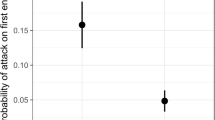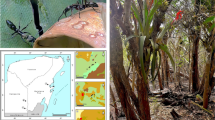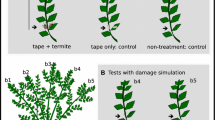Summary
We explore here the occurrence of aggressive ants in an apparently symbiotic relationship with the savanna tree Acacia drepanolobium and their effects on giraffe herbivory on the Athi-Kapiti Plains, Kenya. Trees taller than 1.3 m were more likely to be occupied by aggressive ants in the genus Crematogaster than were shorter trees. Ants wereconcentrated on shoot tips, the plant parts preferred by giraffes. Trees with relatively more foliage had more swarming ants than did trees with less foliage. The feeding behavior of individual freeranging giraffes on Acacia drepanolobium was studied. Giraffe calves exhibited a strong sensitivity to Crematogaster ants inhabiting A. drepanolobium, feeding for significantly shorter periods on trees with a greater number of aggressive ants. Older giraffes were apparently less sensitive to ants, and did not feed for shorter periods on trees with fuller foliage, despite significantly greater ant activity on these plants. The thorns of A. drepanolobium are significantly shorter than are the thorns of A. seyal, a species without symbiotic ants, a pattern that may indicate a trade-off between ants and thorns as defenses.
Similar content being viewed by others
References
Beattie AJ (1985) The evolutionary Ecology of Ant-Plant Mutualisms. Cambridge University Press, Cambridge
Bentley BL (1977) The protective function of ants visiting the extrafloral nectaries of Bixorellana (Bixaceae). J Ecol 65:27–38
Brenan JPM (1959) Mimoseae. Flora of Tropical East Africa. Crown Agents for Overseas Governments, Whitefriars Press Ltd, London
Brown WL (1960) Ants, acacias, and browsing mammals. Ecology 41:587–592
Cooper SM, Owen-Smith N (1986) Effects of plant spinescence on large mammalian herbivores. Oecologia 68:446–455
Dagg AI, Foster JB (1982) The giraffe: its biology, behavior, and ecology. Robert E, Krieger Publishing Co., Malabar, Florida USA
Fiala B, Maschwitz U, Pong TW, Helbig AJ (1989) Studies of a South East Asian and-plant association: protection of Macaranga Trees by Crematogaster boreensis. Oecologia 79:463–470
Hocking B (1970) Insect associations with the swollen thorn Acacia. Trans Roy Entom Soc Lond 122:211–255
Howe HF, Westley LC (1988) Ecological relationships of plants and animals. Oxford University Press, Oxford
Janzen DH (1966) Coevolution of mutualism between ants and Acacia in Central America. Evolution 20:249–275
Janzen DH (1967a) Interaction of the bull's horn acacia (Acacia cornigera L.) with an ant inhabitant (Pseudomyrmex ferruginea F. Smith) in eastern Mexico. Univ Kansas Sci Bull 47:315–558
Janzen DH (1967b) Fire, vegetation structure and the Acacia interaction in Central America. Ecology 48:26–35
Janzen DH (1969) Allelopathy by myrmecophytes: the ant Azteca as an allelopathic agent of Cecropia. Ecology 50:146–153
Janzen DH (1972) Protection of Barteria by Pachysima ants in a Nigerian rain forest. Ecology 53:885–892
Lind EM, Morrison MES (1979) East African Vegetation. Longmans Group Ltd, London
Madden D (1988) Examination of thorns and ants as features of defence for East African Acacia. MS Thesis, California State University, Fresno, CA, USA
McKey D (1984) Interaction of the ant-plant Leonardoxa africana (Caesalpinaceae) with its obligate inhabitants in a rain forest in Cameroon. Biotropica 16:81–99
Milewski AV, Young TP, Madden D (1991) Thorns as induced defences: experimental evidence. Oecologia 86:70–75
Owen-Smith N, Novellie P (1982) What should a clever ungulate eat? Am Nat 119:151–178
Reed JD (1983) The nutritional ecology of game and cattle on a Kenyan Ranch. PhD Thesis, Cornell University, Ithaca, NY, USA
Rosenthall G, Janzen DH (1979) Herbivores: Their Interaction with Secondary Plant Metabolites. Academic Press, New York
Schupp EW (1986) Azteca protection of Cecropia: ant occupation benefits juvenile trees. Oecologia 70:379–385
Young TP (1987) Increased thorn length in Acacia drepanolobium — an induced response to browsing. Oecologia 71:436–438
Young TP, Isbell LA (1991) Giraffe feeding ecology: energetic and social constraints. Ethology 86:79–89
Author information
Authors and Affiliations
Rights and permissions
About this article
Cite this article
Madden, D., Young, T.P. Symbiotic ants as an alternative defense against giraffe herbivory in spinescent Acacia drepanolobium . Oecologia 91, 235–238 (1992). https://doi.org/10.1007/BF00317789
Received:
Accepted:
Issue Date:
DOI: https://doi.org/10.1007/BF00317789




